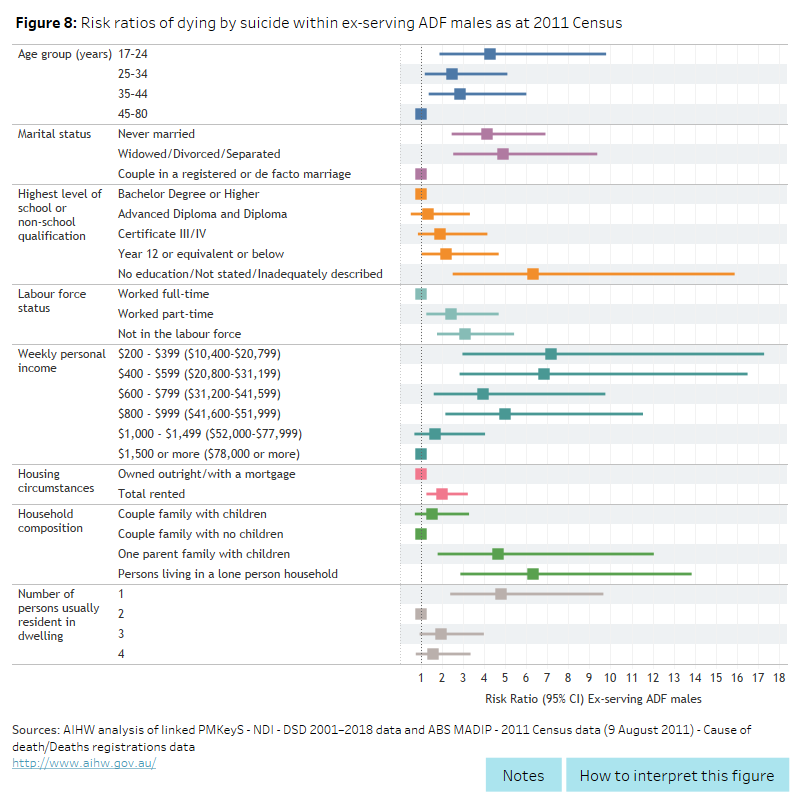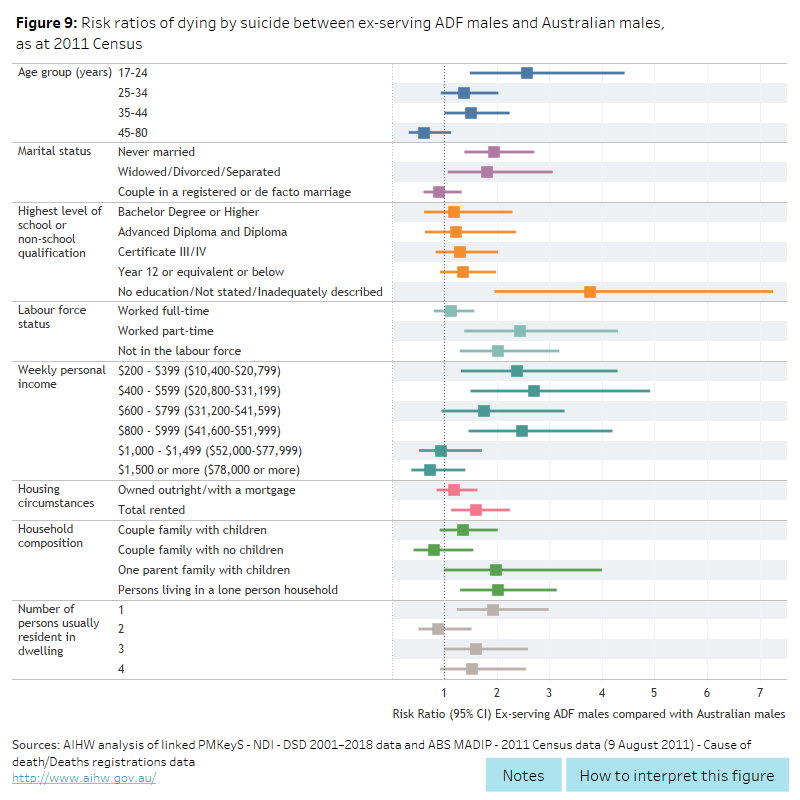Risk of death by suicide
On this page:
Comparisons within the ex-serving ADF male population
Comparisons between the ex-serving ADF male population and the Australian male population
This section explores the risk of death by suicide among ex-serving ADF males and Australian males. It looks at selected demographic and socioeconomic characteristics that may be associated with increased risk of death by suicide.
Data considerations
In order to understand whether or not ex-serving ADF males have different characteristics and experiences as well as risk and protective factors for suicide, it is important to compare them with other Australian males. However, this presents a number of statistical challenges and it is very important to understand what the limitations are and what should be considered when interpreting the data.
Risk ratios are presented in this section which is a measure that gives an indication of the strength of an association between the cohorts being compared. A risk ratio indicates how many times higher the probability of an event (specifically, risk of death by suicide) is in the group of interest compared with a reference group. Differences in the age structure between the populations is likely to be one of the contributing factors to the differences in the risk ratios that have been observed and caution must be taken in concluding that differences are due to ADF service-related characteristics.
Furthermore, this approach does not take into account the relationships between different characteristics and how these may interact to affect suicide rates. The results presented below have not been adjusted for age as the data could not meet requirements to do so. Readers should take this into consideration when interpreting the results presented.
It is difficult to infer patterns or trends in some of the selected demographics and socioeconomic characteristics because small numbers mean that some results are not able to be published. Values based on small numbers of deaths have been suppressed in order to maintain data confidentiality, and/or avoid publishing statistics of low reliability or high volatility. Volatility is related to the size of the study cohort and the number of deaths observed. This means that when comparing small cohorts with other groups, we have less confidence that small observed differences reflect differences in underlying cohort risks.
Comparisons within the ex-serving ADF male population
Age
Younger ex-serving ADF males had higher risks of death by suicide than those who were older.
Ex-serving ADF males:
- aged 17–24 years had 4.3 times the risk of death by suicide as those aged 45–80.
- aged 25–34 and 35–44 years were 2.5 times and 2.9 times respectively as likely to die by suicide as those aged 45–80 years.
It is important to note that although the youngest age group (17–24 years) is associated with the highest level of risk among ex-serving ADF males, it is also known to be associated with other socioeconomic characteristics. Therefore, age may not be the sole contributing factor in the risk of death by suicide.
Relationship status
Compared with ex-serving ADF males who were in a registered or de facto marriage, ex-serving ADF males who were widowed, divorced or separated had 4.9 times the risk of death by suicide.
Ex-serving ADF males who were never married had 4.1 times the risk of death by suicide as ex-serving ADF males in a registered of de factor marriage.
Education
Ex-serving ADF males with lower levels of educational attainment had higher risks of death by suicide. Those with a Year 12 equivalent or below qualification had 2.2 times the risk of death by suicide as those with a Bachelor degree or higher.
Employment
Compared with ex-serving ADF males who were working full-time, ex-serving ADF males who were not in the labour force had 3.1 times the risk of death by suicide. Those who were working part-time had 2.4 times the risk of death by suicide.
Values for ex-serving ADF males who were unemployed and away from work were based on small numbers of deaths and therefore have been excluded from the risk of death by suicide analysis.
Income
The risk of death by suicide among ex-serving ADF males tended to be higher for those who had lower weekly personal income. Those who earned $200–$399 a week had 7.0 times the risk of death by suicide as those who earned $1,500 or more a week.
Values for ex-serving ADF males who had a weekly personal income as negative/nil or between $1-$199 were based on small numbers of deaths and therefore have been excluded from the risk of death by suicide analysis.
Household circumstances
Ex-serving ADF males who lived in a rented dwelling had 2.0 times the risk of death by suicide as those who lived in a private dwelling owned by a member of the household either outright or with a mortgage.
Household composition
Compared with ex-serving ADF males in couple families with no children, ex-serving ADF males who were living in:
- one parent family with children households had 4.7 times the risk of death by suicide.
- lone person households had 6.3 times the risk of death by suicide.
Values for ex-serving ADF males who lived in a group household were based on small numbers of deaths and therefore have been excluded from the risk of death by suicide analysis.
Number of residents usually living in a dwelling
Ex-serving ADF males who usually were the only person living in their dwelling had 4.8 times the risk of death by suicide as those who usually had 2 people (themselves included) living in their dwelling.
Values for ex-serving ADF males who lived in a dwelling with 5 or more people were based on small numbers of deaths and therefore have been excluded from the risk of death by suicide analysis.
Summary
Overall, within the ex-serving ADF male population, socioeconomic characteristics that were more closely associated with increased social isolation also tended to have relatively high risks of death by suicide. These include:
- being never married, divorced, widowed or separated.
- being in a one parent family or living in a lone person household.
- being the only one usually living in their dwelling.
However, as each of these characteristics were analysed without controlling for other demographics (for example, age) or socioeconomic characteristics, they cannot be considered as sole predictors or direct causes of death by suicide.
The interactive data visualisation shows that within the ex-serving ADF male population, socioeconomic characteristics that had a higher risk of death by suicide included; being never married, divorced, widowed or separated, having no education, being in a one parent family or living in a lone person household or being the only one usually living in their dwelling.

Comparisons between the ex-serving ADF male population and the Australian male population
Age
Ex-serving ADF males aged 17–24 years had 2.6 times the risk of death by suicide as Australian males in the same age range. This risk ratio was lower for the older age group (45–80 years).
However, unlike the ex-serving ADF male population where younger age groups generally had higher risks of death by suicide, analysis of age compared with Australian population found no distinct pattern or trend among the different age groups.
Relationship status
Ex-serving ADF males who were never married or were divorced, widowed, or separated had around twice the risk of death by suicide as Australian males who were never married or were divorced, widowed or separated. Risk levels were similar among ex-serving ADF males and Australian males who were in a registered or de facto marriage.
Education
Generally, the risk of death by suicide between ex-serving ADF males and Australian males was similar across all level of highest educational attainment. While those in the no education/not stated/inadequately described group are shown to have the highest risk of suicide, the confidence intervals are wide meaning we have less confidence in the observed difference.
Employment
Ex-serving ADF males who were working part time had 2.4 times the risk of death by suicide as Australian males who were working part time, while ex-serving ADF males who were not in the labour force had twice the risk of death by suicide as Australian males who were not in the labour force.
Values for ex-serving ADF males who were unemployed and away from work were based on small numbers of deaths and therefore have been excluded from the risk of death by suicide analysis.
Income
Ex-serving ADF males who were earning $400–$599 a week had 2.7 times the risk of death by suicide than Australian males whose income was in the same range. Ex-serving ADF males who were earning $1,000 or more a week had a similar risk of death by suicide as Australian males who earned $1,000 or more a week.
Values for ex-serving ADF males who had a weekly personal income as negative/nil or between $1-$199 were based on small numbers of deaths and therefore have been excluded from the risk of death by suicide analysis.
Household Circumstances
Ex-serving ADF males who were living in a rented dwelling had 1.6 times the risk of death by suicide as Australian males who lived in a rented dwelling.
Household Composition
Ex-serving ADF males who were living in lone person households, had twice the risk of death by suicide as Australian males living in a lone person household.
Values for ex-serving ADF males who lived in a group household were based on small numbers of deaths and therefore have been excluded from the risk of death by suicide analysis.
Number of residents usually living in a dwelling
Ex-serving ADF males who were usually the only person living in their dwelling had 1.9 times the risk of death by suicide as Australian males who were usually the only person living in their dwelling.
Values for ex-serving ADF males who lived in a dwelling with 5 or more people were based on small numbers of deaths and therefore have been excluded from the risk of death by suicide analysis.
Summary
Generally, patterns for risk of death by suicide for each of the characteristics examined when comparing ex-serving ADF males with Australian males, were similar to that when comparing within the ex-serving ADF male cohort.
The interactive data visualisation shows the risk of death by suicide in the ex-serving ADF male population compared with Australian males by selected demographic and socioeconomic characteristics. Overall, the size of the suicide risk for each of the risk factors is two to three times as high in the ex‑serving ADF male population as in the general Australian male population.



